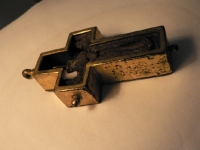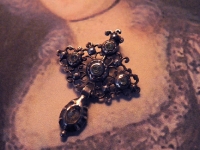



In the inter-war period gave garnet jewelry a new impulse thanks to its capacity to adapt to the Art deco style. The number of jewellers is significant and covers most of the area of the Pyrénées-Orientales. Behond the great jewellery houses, such as Velzy or Charpentier of Perpignan, Prades is notable for its revival under Joseph Calvet, who married the heiress of a century-old Quès jewellery house, , in 1921. … Continuer la lecture
The Garnet in all its forms One of the most audacious creations in Catalan jewellery at the end of the 19th century was to totally abandon the mounting of other stones in favour of the garnet, with its subtle compositions, in advance of its time. Through their mastery and a perfect adaptation to the market, the jewellers at the end of the Second Empire were able to breathe a … Continuer la lecture
Jewelry symbolizes strong feelings: love, friendship, remembrance of a loved one. But in a region of two cultures sometimes Hispanic, sometimes French, whose relationships were always changing, the traditional craft was preserved. These precious objects always have always played a part in the culture of presentation of the Catalan population, proud of its heritage, from one generation to the next. In the first half of the 19th century, with the … Continuer la lecture
Turning gold into wire In Perpignan gold is exclusively used for Garnet jewelry. Mined industrially near the village of Glorianes (Pyrénnées-Orientales) from the 1920s to the 1960s, Catalan gold has been used since time immemorial. Processed and worked into fine sheets or wire of different thicknesses, gold is first passed through a manual or an electric machine to refine the metal. In the nineteenth century Catalan jewellers were specialized in … Continuer la lecture
The legacy of the nobility In the Second Empire a new interest about the 18th century gave birth to the decoratives arts in the Pompadour style. Promoted by the Empress Eugénie, attracted by the personality of Marie Antoinette, this trend was to have a great influence on the jewelry culture. Roussillon contributed to the trends of the day in the form of a prestigious and imposing cross called the badine … Continuer la lecture
All the garnets of Perpignan are cut and worked for mounting in a typical style i.e. with a flat base and only work on one side. Best on ancient traditions, Catalan jewellery alone continues to practise this type mounting which has disappeared everywhere else in Europe, and the Catalan stones are finer. Today, stone-cutting workshops of Idar-Oberstein in German Palatinate have taken over from the workshops of Saint-Claude in the … Continuer la lecture
In order to enhance the lumisosity and brilliance of the Garnet, sheet of silver foil with a red tint (paillon) is delicately cut then placed inside the setting. It served to reflect the light and give brilliance to the stone. The “paillon” is usually the same colour of the stone except in the case of “brésils”, which means citrines placed on red “paillon”, giving them orange reflexion. This … Continuer la lecture
Rock formation Originally extracted in their natural state in the Pyrénnees, the garnet is today mostly mined in countries such as Mozambique, Kenya, Tanzania, Madagascar, Sri Lanka and India. In Europe the most famous is the Bohemian garnet in the Czech Republic. During the successive crystallization processes, involving changes in pressure and temperature, atoms and ions arrange themselves in a regular pattern. This crystalline structure takes a cubic form … Continuer la lecture
A complex gem Garnets are a group of complex neo silicates in a regular cubic form. The crystals are most often in a form of a hexaoctahedron and a rhombododecahedron. Their average hardness is 7.5 and their density of 4.32 which allows their use in jewellery. Their colour covers a broad palette with many shades of red. Since time immemorial, garnets have been used in jewellery; reds and purples … Continuer la lecture
Ce bijou a été offert à la Poésie catalane par Frédéric Mistral et Roumanille. Il porte sur le ruban l’inscrition suivante: Provence et Catalogne ont feuri, et donneront des graines. Le début du XXe siècle voit l’éclosion de nombreux bijoux régionalistes. Toute contribution est la bienvenue pour la localisation et l’histoire de ce bijou. Photographie parue dans Féminal, l’Illustracio Catalana, 1914.